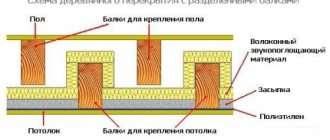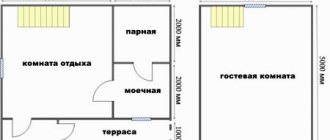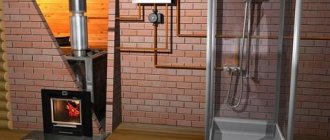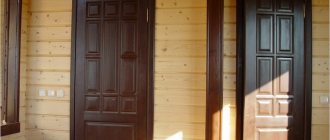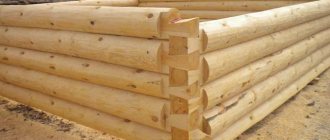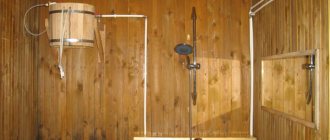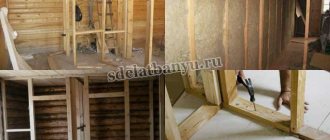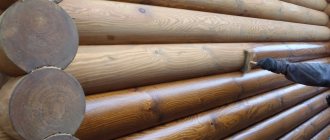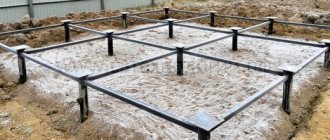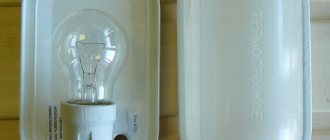Home / Bathhouse / Features of various rooms / Bathhouse with an attic - how to insulate the ceiling?
The bathhouse has long ceased to be just a place where you can just take a steam bath with a broom. Many people set up entire bathhouse complexes on their property, consisting of several rooms and often two-story. The most common option is a bathhouse with an attic floor, in which there is a recreation room or billiard room. But such a building needs good insulation. We will look at how to insulate the ceiling in a bathhouse with an attic in this material.
Main types of attic roofs
- Cold - for their installation, a sheathing is stuffed onto the rafters, taking into account the roofing covering, roofing material is attached to it, insulation is carried out along the ceiling, laying thermal insulation on it, which is covered with a vapor barrier on the room side, and a waterproofing membrane on the attic side;
- insulated - for exploited under-roof spaces - attics, additional elements are added to the previous components: insulation, vapor barrier, waterproofing, counter-lattice - timber with a section of 40 x 40, 50 x 50, 60 x 60 mm, placed on the rafters along their length. A waterproofing material is laid on the beam, protecting the insulation and roof from external moisture, then the sheathing is laid on which the roofing covering is attached. The spaces between the rafters are filled with appropriate insulation, and from the attic side it is covered with a vapor barrier layer.
Types of bathhouse ceiling insulation:
- outside - more convenient to use, most effective for a ceiling located under an uninsulated roof, the insulation is laid out on the attic floor and covered with a rough or finished floor;
- from the inside – it prolongs the durability of the material, there are no temperature changes, but you will have to “steal” a few centimeters of the height of the bathhouse, a frame is mounted on the ceiling, after fixing the first layer of vapor barrier, and insulation is placed in it, then the vapor barrier is again and the ceiling covering is attached.
Finishing work
Scheme for finishing the attic with clapboard.
Before you begin finishing work, you need to carefully consider the entire layout. You may want to use the attic not as one large room, but as several rooms or to place some built-ins. In this case, you must first install all the additional elements, additional parts, and only then begin finishing.
The easiest way to decorate the interior surfaces of the attic is with lining made of hardwood or softwood. Such finishing does not require specific skills and is carried out in the shortest possible time. Instead of wooden lining, you can also use modern plastic panels. A huge range of colors and textures will allow you to create the most unexpected interior in your attic.
With a cold roof or with an attic - what's the difference?
An attic is a floor in the attic space, i.e. the premises in use have an insulated roof and an existing floor, so it is more convenient to carry out repairs or installation of insufficient insulation from inside the bathhouse. And if the ceiling has a cold roof, then it is more convenient to install the heat-insulating “pie” from the outside, i.e. from the attic side.
If there is an attic floor, there is a problem with the penetrating temperature threshold from the steam room, from where a large amount of steam, warm and hot air rises and, accordingly, if it is not properly disposed of, it will accumulate in the attic space. Therefore, in order to insulate the ceiling in a bathhouse with a cold roof, you should carefully calculate the thickness of the ceiling insulation taking into account the loads and take care of better vapor and waterproofing.
There is an opinion that it is not necessary to insulate the ceiling in a bathhouse with an attic, but increasing the thermal insulation characteristics in it is more necessary than in an uninsulated attic space, where the heat penetrating outside does not encounter serious obstacles on its way.
The technology of the insulation process, the selection of thermal insulation material between the attic floor and the cold ceiling has few differences.
Methods
First of all, it is worth deciding what method will be used for insulation. There are two main options:
- Internal insulation
- Insulation from outside
Both methods have the right to life and are not without drawbacks. The second option can generally only be used when the entire structure is being built. The insulating layer is laid in the walls and ceilings of the attic during the construction of the entire bathhouse. Afterwards, this method will not work.
The internal method of laying insulation is available at any time. Even if the bathhouse was still used as a one-story building, and it was only now decided to make the attic floor habitable.
Insulation of the ceiling in a bathhouse with a cold roof
Warm air is lighter than cold air, so it rushes upward. Without meeting a barrier, it will heat the atmosphere; in order not to take part in the progress of global warming, it is necessary to organize proper thermal insulation. Air masses filling the under-roof space, of course, retain heat leakage, but this is not enough.
With properly carried out thermal insulation measures, the time for heating the room is significantly reduced, fuel is saved, heat and steam are saved longer, and the service life of the ceiling increases . Installing insulation in a multi-layer roof system prevents many types of heat loss.
How to insulate
Before laying the thermal insulation layer, a vapor barrier is laid. It prevents the transit of wet vapors and their settling in the insulation layer, because Water accumulated in the thermal insulation will increase the weight of the ceiling system and deteriorate the insulating qualities.
The following are used as a vapor barrier layer: aluminum foil, compacted cardboard impregnated with drying oil, wax paper, special film with lint, membrane material.
For more information on using foil, see this page
How to insulate
Ceiling insulation with sawdust
Traditionally, people insulated wooden houses with sawdust and lived without bothering in warm houses in severe frosts. People still recommend insulating the ceiling with dry straw and fragrant sawdust to this day. They are environmentally friendly, safe, hypoallergenic, natural. No special skills or special tools are required to use them.
If there is a solid base, a vapor barrier is first laid: roofing felt, rubimast, high-strength cardboard or membrane film; the edges are brought out to the sides of the beams and attached with a stapler to prevent spillage downwards. The cracks are first filled with foam. Then sawdust is poured in, pure or with impurities.
Sawdust-based insulation compositions
Sawdust-based insulation compositions are:
- clean - sawdust of different fractions is used, a rough layer - coarse shavings - 10 cm, finishing - another 10 cm of fine shavings, usually this thickness coincides with the height of the beams, a diffuse membrane is spread on top so that the sawdust does not fly apart;
- with clay - first option : lay out a layer of crumpled clay - 20-25 mm, on top of sawdust as a thermal insulation layer - 10-15 cm, dry earth - 10-15 cm;
- second : shavings are mixed with clay in equal volumes and laid out on a prepared base 10 cm thick; clay to sawdust ratio 2:3;
ATTENTION ! The service life is significantly shorter than that of other insulation materials.
- with cement - sawdust is mixed with cement in a ratio of 10:1, mixed with water to a very thick solution, laid in a layer 20-30 cm thick, antiseptic and fire retardants are added if desired.
Read also : Should I insulate the ceiling of a bathhouse with clay and sawdust or sawdust with cement? Which is better and is there a difference?
Clay-based solutions
Clay concrete is obtained by mixing: sawdust, clay, lime, cement or gypsum with water. To knead 1 cube you will need: 200 kg of sawdust, 300 kg of cement, 70 kg of lime, 300 kg of clay, 350 liters of water. First of all, combine the dry ingredients, then add lime and clay. The result is a solution with good thermal insulation qualities, durable, reliable, inexpensive, and does not rot.
Clay-sand - the ratio of sand and clay is 2:6, water is added to the consistency of sour cream. The cracks of the flooring are covered with liquid clay, after drying, a vapor barrier membrane is laid with an overlap of 15-20 cm, the joints are glued with foil tape, the base is evenly covered with a mixture of sand and clay with a thickness of 5-7 cm, after hardening, we fill it with 10-15 cm of dry sand, logs can be mounted on top and finishing floor.
Expanded clay
Bulk type thermal insulation material. An environmentally friendly product, made from clay, perfect for thermal insulation of a bathhouse ceiling. Main properties: non-flammable, does not emit harmful substances when heated, light weight, does not create additional load. To insulate the ceiling, expanded clay with a fraction size of 4-10 mm is used, the layer thickness is at least 30 cm.
Useful video
Watch a video about how to properly use expanded clay for ceiling insulation and what mistakes to avoid:
IMPORTANT ! Expanded clay does not tolerate contact with moisture well; waterproofing is required when used.
Minvata
Mineral-based fibrous insulation is produced in the form of mats, slabs, and rolls. It is considered the most effective for thermal insulation of ceilings, it has a long service life, although it also costs more. Properties of mineral wool: retains heat well, noise insulator. Placed between floor joists. For a bathhouse with an insulated attic, a thickness of 10 cm is sufficient, with a cold ceiling of 15-20 cm.
REFERENCE ! Modern manufacturers produce thermal insulation materials with a special waterproofing protective layer made of foil polyethylene foam or foil.
Other insulation materials
• ecowool made from small cellulose fibers; • polystyrene foam boards are a favorite among heat-insulating building materials due to their ease of installation and low cost; • folgoizol is used to preserve the heat of the ceilings of baths and saunas; it is not subject to corrosion and decay from the environment. • polyurethane foam – a material sprayed using special equipment.
Used insulation materials and calculation of the thermal insulation layer
In order for an insulation system to be sufficiently effective and not become a waste of money or, worse, do more harm than good, it must meet certain requirements. And the main one is that the thickness of the thermal insulation is selected in such a way that the total heat transfer resistance of a particular building structure corresponds to the standardized parameters established by SNiP for a specific region (taking into account its climatic characteristics).
Any thermal insulation system must be created for reasons of sufficiency, based on calculations.
Of course, this can only be achieved by using materials with markedly low thermal conductivity. But at the same time, it is necessary not to forget about other criteria - the comprehensive safety of using the insulation, its ability to withstand specific bath conditions (high temperatures and humidity).
Calculation of a thermal insulation system is a rather complex undertaking, which is usually carried out by appropriate specialists. However, without claiming absolute accuracy, we will take the liberty of offering the reader a calculation algorithm that takes into account all the basic existing requirements. It will be presented in the form of a universal calculator that allows you to determine the thickness of insulation for both the bathhouse roof slopes and the attic floor. But before moving directly to the calculations, it is necessary to give some explanations.
One of the first points in the calculator will ask you to indicate the planned insulation material. We will not dwell on each of them in detail - a whole array of articles on our portal is devoted to this, but each one still deserves a few words.
- Mineral wool is presented in the calculator in two varieties: based on glass and basalt fibers.
Both of these types have approximately the same thermal insulation characteristics - their thermal conductivity coefficient, depending on operating conditions, lies in the range from 0.038 to 0.045 W/m×°C, which is a very good indicator. Glass wool is somewhat cheaper in cost, but perhaps this is the only advantage. For roof insulation, and even more so for bathhouses, the best option would still be the basalt variety.
We suggest you read: Do you need special lamps for a Russian steam bath?
The initial characteristics are very similar, but it is still better to give preference to basalt mineral wool (right)
Basalt wool fibers are less brittle, and this makes working with it much easier. In addition, this same quality makes the material more durable - it has a much less pronounced tendency to gradual caking and compaction, with loss of thermal insulation qualities. Another advantage is that basalt wool usually has less pronounced hygroscopicity, that is, it is not so saturated with moisture.
Both cotton wool contains synthetic binders that can release harmful fumes into the air, especially at elevated temperatures. Technologists from leading manufacturing companies have managed to reduce such emissions to a minimum, and the most “clean” materials should be selected for the bathhouse - usually the packaging indicates approval for use in residential premises, and even in children's or medical institutions.
The most important advantage of mineral wool is its non-flammability, ability to withstand fire and not emit hazardous combustion products.
In a word, all this gives reason to consider high-quality mineral wool (preferably basalt) as one of the best options in a bathhouse.
- Next on the list of insulation materials is ecowool. This is a relatively new and not yet widely known material, which is a product of processing natural cellulose.
It would seem that cellulose is both a fire hazard and a tendency to gradual biological decomposition. However, in the case of ecowool, everything is exactly the opposite. Special processing of fluffed fibers and the presence of boric acid and sodium tetraborate (borax) in the material composition radically change its properties.
Ecowool not only does not decompose on its own, but also becomes a powerful antiseptic that has a beneficial effect on the wooden structural elements surrounding it. Rodents and insects do not welcome it; mold or mildew will never spread in it. And borax is an effective fire retardant - cotton wool does not ignite even when exposed to open flame.
basalt wool
Ecowool can be used to fill cavities or cover walls and partitions.
Ecowool can be installed in the cavities of insulated structures using a “dry” method, but in this case it is more susceptible to gradual shrinkage. Another method of application is to apply it to surfaces using “wet” technology, using special equipment. With this installation, thermal insulation becomes more durable and effective, but it will be impossible to perform such an operation on your own, without experience and without the appropriate equipment.
- The next item is polyurethane foam. It can rightly be called one of the most effective insulation options. Possessing excellent adhesion, it will create a durable porous thermal insulation “coat” on any surface - horizontal, vertical or even with a negative angle of inclination - such as on the back side of a roof slope. In this case, the thermal conductivity coefficient can be only about 0.030 W/m×°C.
One of the most effective thermal insulators is sprayed polyurethane foam.
The widespread use of this insulation method is probably only hindered by the need for special equipment, which means that you will have to resort to the rather expensive services of specialists. Disposable kits for self-application of the material have also appeared on sale - with all the necessary components and accessories. However, their cost cannot yet be called affordable either.
- Insulation based on polystyrene.
This includes the widespread and very inexpensive polystyrene foam, as well as a more advanced variety - extruded polystyrene foam (a typical representative is the popular "penoplex"). These materials themselves are very good thermal insulators, but they can be used to insulate a bathhouse with some caution.
Polystyrene foam and extruded polystyrene foam are not the best option for insulating a bathhouse
Firstly, the materials do not have thermal resistance - temperatures in the region of only 80°C are already beginning to have a destructive effect on them. Polystyrenes are unstable compounds, and the process of depolymerization cannot be ruled out, with the release of gases that are very dangerous for humans, and this phenomenon increases with increasing temperature.
Thus, there should be no talk of using it inside bath rooms at all. Secondly, the material becomes extremely dangerous in the event of a fire - it is capable of burning, spreading a “liquid” flame when melted, and the smoke released during this process is deadly. For these two reasons, in many countries, polystyrene foam is legally prohibited in any residential construction.
In the context of our publication, polystyrene foam (preferably extruded) can be considered only for insulating the roof slopes above the bathhouse, if it is not possible to use another material.
- Next - bulk mineral insulation. We include expanded clay and vermiculite in this category.
Both of these materials are more often used for insulating horizontal structures, that is, attic floors. Quite rarely, but still sometimes they are used to create a thermal insulation layer on roof slopes with a small angle of steepness.
The main advantage of bulk mineral insulation, expanded clay and vermiculite is environmental friendliness and complete safety in operation.
The natural mineral structure and the absence of any “chemistry” makes these insulation materials absolutely “clean” from an environmental point of view, non-flammable, not subject to decomposition or rotting. There will never be nests of insects or rodents in them.
Expanded clay is cheaper, but its insulation qualities are still significantly lower than those of most common insulation materials mentioned above. That is, to create effective thermal insulation, you will need a fairly thick layer of material.
Vermiculite has thermal conductivity comparable, for example, to mineral wool materials. Another advantage is its ability to absorb moisture from the air and release it with the same ease - thus, it serves as a kind of “regulator” of humidity, maintaining an optimal regime. The only disadvantage of vermiculite is its high price - not everyone can afford to create a full-fledged thermal insulation structure based on it.
- Finally, natural organic materials are traditionally used to insulate attic floors. For these purposes, sawdust, shavings, dry pine needles, and some types of peat moss have long been used.
The advantage of such insulation is that the material can often be found almost free of charge.
Sawdust can simply be poured into the cavity (for example, between floor beams), but this material can cake over time, losing thickness and, accordingly, in insulating qualities. Of course, special treatment is necessary that will prevent the processes of decay of organic matter or the appearance of fungal infections, nests of insects or rodents in it. Most often, they do not just dry backfill, but mix the material with a binder - this role can be clay or cement.
Insulation of the ceiling in a bathhouse with an attic
The attic room is the coldest in the bathhouse, because... does not have a “thermal cushion”, so insulating the ceiling in a bathhouse with an attic is the most important task; with such a structural design, thermal insulation is used for both the second floor floor and the roof. After all, the excess heat from the bathhouse fully heats the attic room, and the heat-insulating layer prevents it from overheating.
Conserving heat under the roofing material is also necessary. Both in winter and summer, you will be comfortable. Under the summer sun, the roof heats up, the outside heat combines with that coming from the steam room, and as a result, on a bath day you will get a scorching heat on the second floor.
How to insulate
The approximate “pie” of insulation from the inside of a steam room (about insulation for a steam room here) is as follows:
- lining;
- rail;
- foil taped with tape;
- rough board 150 x 20 mm;
- floor beam;
- glassine;
- expanded clay – 120 mm;
- Rockwool insulation – 50 mm;
- glassine;
- batten.
Useful video
Look at the explanation of the above illustration of a bathhouse roof pie with an attic:
Read more about mansard roofs for baths here.
How to insulate
What thermal insulation material should I use? Yes, everything that is listed above, from time-tested, natural, natural insulation materials to ultra-modern ones (wood chips, shavings, sawdust, sand, expanded clay, mineral wool, basalt wool, ecowool). More information on insulation for baths here.
Important points
With any method of laying insulation, it is important to understand that under the attic floor there is a steam room and all adjacent rooms. This means that at the second level a greenhouse effect is possible. This must be avoided at all costs, as steam will quickly render the entire structure unusable.
To do this, you need to take care of high-quality hydro and vapor barrier of the ceiling between levels. Ventilation will also be of utmost importance. The comfort of being inside and the service life of the building depend on how well the entire building is ventilated. Moreover, it is necessary to provide ventilation not only in the attic, but also in the bath complex itself.
conclusions
Heat leakage problems need to be solved comprehensively, and not just those discussed in this article. There are no trifles in organizing thermal insulation; window and door openings, walls, roof, ceiling, floor - everything must be done correctly, in compliance with building codes and calculations taking into account your region. When insulating the ceiling in a bathhouse with an attic, you should also take into account the thermal insulation features of buildings made of different materials: foam block, brick, frame, timber or logs.
Office, workshop or library - arrangement of the attic floor
You can set up a games room in the attic.
The interior design of the attic must begin with the choice of stairs. Depending on your wishes, it can be made in various styles and from any type of wood. Where to place the lift on the first floor also depends only on you.
To make the staircase as safe as possible, it is made flat, with wide steps. It should be remembered that this measure is necessary because a person after a steam room is in a relaxed state and can easily slip on flat and narrow steps. An additional decoration for the staircase can be railings with carved original balusters.
Other elements of the attic interior depend on the purpose for which you need this area. Most often it is used as a relaxation room, which means it is necessary to provide a comfortable sofa, armchairs, table and chairs. Perhaps, after the bath procedures, you will want to watch TV or play billiards - equip the room with all the desired details to make your stay as comfortable as possible.
If you follow all the rules stated above, then your bathhouse with an attic will delight you for many years. Treatments in the steam room will warm the body and improve health, and time spent in the attic will complement the healing effect, giving real relaxation.
The attic must be provided with proper attractiveness and comfort, regardless of its purpose. The choice of design depends on many factors, but there are general rules for equipping areas under the roof. They will be useful for competently creating a project and will help provide the premises with comfort and a stylish look. In the design of the attic you need:
- successfully play with inclined walls, beam systems, rafters;
- ensure maximum intake of natural light;
- create a high-quality artificial lighting system;
- use compact low furniture, limit the number of elements;
- give preference to moisture-resistant finishing materials;
- apply design techniques that visually increase the area.
To decorate the attic, use compact, low furniture
Particular attention is paid to the installation of communications. If the attic is intended for year-round use, it is necessary to create a high-quality, reliable roofing “pie” that eliminates heat loss and install a heating system. Ventilation will be required in any case. In the summer, the attic will heat up; it is important to install air conditioners and provide natural, forced ventilation. This will create the proper comfort.
The specificity of the area under the roof requires a responsible approach to interior design. You can order the development of a project from a professional designer. If this service is not available, it is worth studying photos of attic designs on the Internet. On specialized sites there are a huge number of ready-made projects that can be used as the basis for creating your own version.
Where to order or buy
When building a bathhouse or having problems with heat preservation in an already in use building, it is better to turn to professionals or get their qualified advice than to comprehend the science of construction by trial and error. But for those who prefer to master the techniques of building and thermally insulating a bathhouse on their own, you should pay attention to companies that sell insulation materials.
E-mail
Article in sections: Roofs of bathhouses > Insulation of the ceiling in a bathhouse
